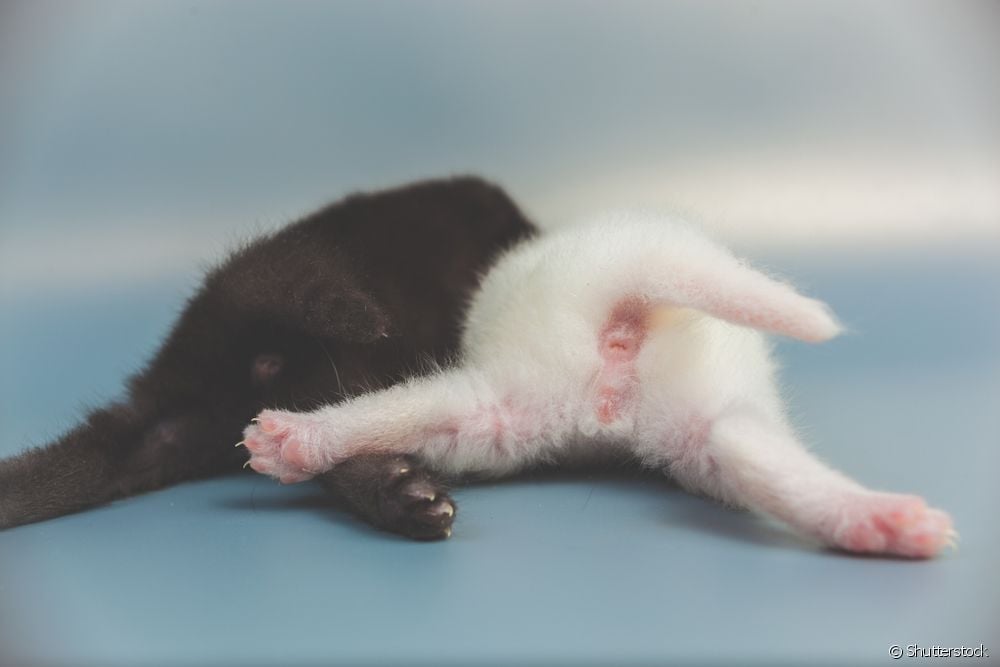Inflamed adanal gland of cats: what is it, causes and how to treat?

Table of contents
When it comes to an inflamed anal gland in cats, home treatment should be avoided and we'll explain why. This condition is usually more common in dogs, but felines can also suffer from this infection, especially after a cat with diarrhea.
It turns out that these pouches located in the anus region are super sensitive: any little thing can trigger an inflammation of the adanal gland in a cat. Therefore, all treatment of these pouches must be mediated by a veterinarian to avoid complications. Several symptoms surround this discomfort and if you are looking to understand more about it, the following article explains you better on this topic.
What is inflammation of the adanal gland in cats?
To better understand, it is first interesting to explain what the adanal glands are and what they are for. These two pouches, which are located around the anus, are responsible for releasing a foul odor that helps animals leave their trail in the feces. This secretion, brownish and foul-smelling, also facilitates evacuation by lubricating the area. But it is not only at the time of defecation that it releases this odor.liquid: moments of stress or great calm can also cause the substance to be expressed.
It's no news that the anal region of pets are super sensitive and any change already becomes a big problem. With the adanal glands, it's no different. The accumulation of this secretion, as well as manipulating the area to remove the substance (without the slightest need), are just some of the reasons that trigger an infection.
Squeezing the cat's adanal gland is one of the causes of inflammation
Usually, the main reason for a cat with an inflamed adanal gland is unnecessary emptying of the pouch. It turns out that the secretion naturally comes out along with the feces and many pet shops have a protocol of releasing the substance as a wrong form of hygiene. However, this generates more secretion production, which can inflame the glands. The whole process happens as follows: the accumulationresults in a fistula (called perianal) of the gland that releases the already infected fluid, mixing with bacteria present at the site. In other words, you should not touch the gland!
However, that's not all, for some reason the feline can also produce more secretion than normal, resulting in the same problem. An example is the cat with constipation or diarrhea, as both are situations in which there is no stimulation of the bags and the liquid accumulates. And the lack of hygiene also attracts bacteria in the region that can generate an infection.

Cat with inflamed adanal gland has several symptoms
This condition has physical signs that also impact on the cat's behavior. Among them are more common and visible:
- Enlargement of the adanal glands (may be one or both)
- Redness (or whiteness)
- Outflow of purulent and foul-smelling fluid
- Fistula in the region
- Cat with discomfort when defecating
- Itching (excessive licking of the site)
- Feline showing pain when sitting down
- Animal dragging the area on the floor or rubbing against legs and furniture
- Cat with a bad smell
Another symptom is the cat running out of nowhere and this is a difficult sign to identify, given that this is normal feline behavior. But unlike that run that denotes a joke, the cat runs out as if the region were sore, because the inflammation also generates a lot of pain, as if something were "hooking" the gland. So it is likely that he runs out and emitsa brief meow of pain.
How to treat adanal gland inflammation in cats?
Infection in the cat's adanal pouch is difficult for the guardian to notice, as it is often mistaken for ringworm in cats. Diagnosis, performed by a veterinarian, involves analysis of clinical symptoms and evaluation of physical symptoms, with touching of the region to identify the degree of inflammation, as treatment varies according to the state of the condition.
Generally, the best way to treat an already burst adanal gland in cats is with oral and especially topical medication, considering the difficulty of oral medication to reach the region. The medications, indicated by a veterinarian, are antibiotics and anti-inflammatories, as well as analgesic ointments with local application to avoid pain. The average treatment time is 15 days and, withIf the condition improves, the gland is drained.
See_also: Pitbull names: see a selection of 150 names for the dog breedUnfortunately, it can happen that the inflammation is recurrent. In these cases, a fortnightly drainage is performed until the lesion decreases to perform a surgery to excise the bag. The tutor should never manipulate the glands and try to empty them at home. There is a whole technique for this and only a professional can do this touch.
To avoid inflammation of the adanal gland, cats should have good nutrition and hygiene
At home, it is recommended to maintain a good diet for your cat to avoid diarrhea or constipation, as both can result in an accumulation of secretion in the glands due to lack of stimulation. So invest in a premium food and control the amount served so as not to have an obese cat.
Hygiene is also essential as it prevents the presence of bacteria in the area. But remember that during the cat bath, you cannot squeeze the gland. If the feline is bathed in pet shops, ask the professional not to touch the feline adanal pouches. A good cleaning routine also prevents excessive licking of the area, which can cause trauma that ends in fistulas.
See_also: Why do cats bring gifts to their owners?If your cat shows any signs of discomfort, seek veterinary help to start treatment. It is also important to know if your cat has worms, so as not to confuse the conditions.

